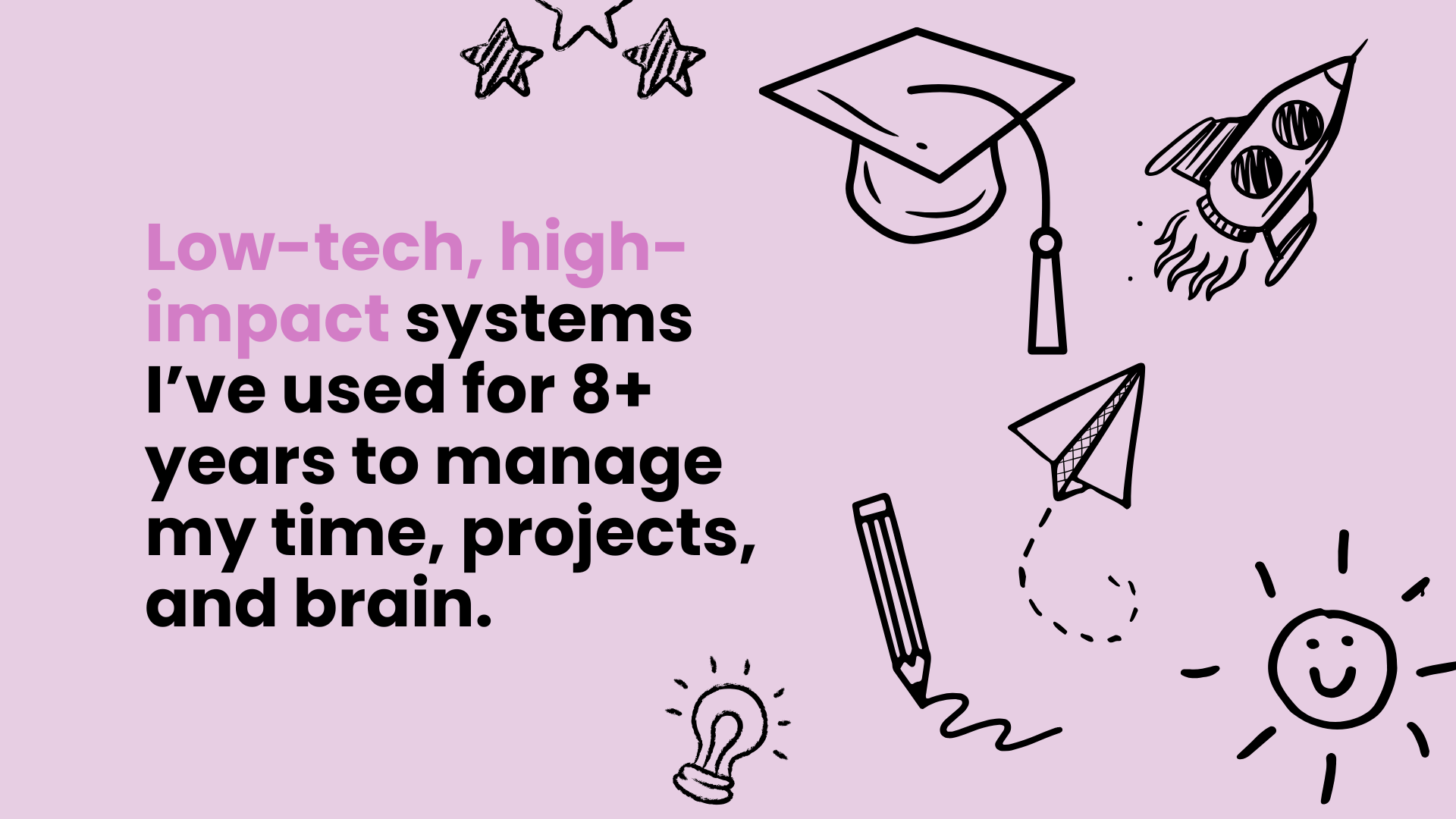Ever wondered what happens after you build your Kanban board? In this post, I share the analog systems I use alongside Personal Kanban to manage tasks, shape projects, and keep my brain (and business) running smoothly. It’s the behind-the-scenes setup that helps me actually finish things—and feel good doing it.
If you’ve just finished my 3-day Personal Kanban challenge, you’re already up and running with your board.
You’ve built a tactile system to capture, prioritize, and visualise your work.
But the question I always get next is:
“What else do you use?”
Because let’s be honest: a Kanban board can only show what you’ve already figured out. It doesn’t help you shape ideas into focused projects.
Or plan your week around your energy.
Or decide what not to do.
That’s where the rest of my analog systems come in.
Below is a peek at how I actually manage my time and work using Personal Kanban, plus a few powerful add-ons.
These are the low-tech, high-impact systems I’ve used for 8+ years to manage my time, projects, and brain power.
1. Personal Kanban: The System That Shows Me What I’m Doing
As you already know, this is my go-to framework for seeing the shape of my work.
Every task I commit to goes on a sticky note and moves through the columns: Options, Ready, Today, The Pen (work in progress), and Done.
It helps me organise my tasks, limit my work in progress, stay realistic about capacity, and most importantly—see what’s getting stale. If something’s been sitting around too long, I know to either act on it or let it go.
But Kanban doesn’t work in isolation. So here’s how I support it…
2. The Blank Page
Every day, I keep a single piece of paper next to me.
Anytime a distracting thought, task, or idea pops up mid-focus, I jot it down here instead of breaking my flow.
At the end of the day (or first thing the next morning), I triage that page:
- Turn it into a ticket
- Add it to a project doc
- Or cross it off and forget it
This small habit helps me stay focused and capture ideas without letting them derail my day.
I learned this from a friend of mine, Rob Hatch. And it’s been a massive upgrade for maintaining focus and avoiding context switching.
3. My Behind-the-Scenes Notebook
This isn’t for task capture or any kind of organisation.
It’s for thinking.
When I’m in the middle of a job and need to work through messy thoughts, write down numbers, sketch out how something fits—I use this notebook.
It’s for scratchpad thinking that helps me do the work better.
These are throwaway notes (that, funnily enough, I never throw away…)
4. Three Journals: One for the Mindset, One for the Mess, and One for a Weekly Review
(1) The 5-Minute Journal: I use this for daily mindset maintenance; quick prompts around gratitude, daily intention, and end-of-day reflections. It’s something easy I can do first thing that generates a positive mood and outlook.
(2) Free-writing Journal: This is where I brain dump, write about my feelings, explore my problems, or process resistance. It’s not tidy, but it helps.
(3) Weekly Review: This is more of a scrapbook-style journal. I print out pictures from the week and write down what happened. It’s more personal/family-focused and has more of a creative feel. I get to use my “special markers,” which makes it more fun.
BONUS: I also use another journal to copy out the text from books I love (yes, word for word—not just highlights!). This is both therapeutic (I love to write by hand) and great for skill development. Copying out writers’ work you enjoy makes you a better writer. Plus, it hammers home the best lessons from the book.
5. My Focus Finder (You’ve Done This One!)
This was your Day 1 homework in the challenge. I repeat this brain-unloading process every month (or anytime I feel chaotic).
I use it to:
- Reset when I feel overwhelmed
- Spot hidden tasks and unfinished threads
- Generate the master list that fuels my board
6. Project Shaping (AKA: How Things Get on My Board in the First Place)
Kanban is great for execution. But how do I figure out what to execute?
That’s where shaping comes in.
It’s a short process I run every 6 weeks to:
- Choose a meaningful project for myself (not client work!)
- Define what “done” looks like
- Break it into 4 weeks of work
This process powers my bigger goals and side projects—and gives me something worthwhile to track on the Kanban board.
7. Recurring Tasks + Color Coding
On my board, I:
- Use different colors for different types of work (client, personal, sales, etc.)
- Reuse sticky notes for recurring tasks (like newsletters or bookkeeping) until they fall off the wall
- Keep recurring tasks visible in a dedicated “RC” column
It sounds basic, but it makes a huge difference in keeping things visible without letting them take over.
8. The Done Column Is Data
Every week, I hold a quick retrospective. (You learned about this in the challenge, too.)
But here’s the twist: I look for patterns in what drained me, what gave me energy, and what actually mattered.
Sometimes I:
- Add a smiley or frowny face to finished tickets
- Notice which types of tasks I avoid (they might need to go! Or I need to add in some support to help me follow through)
- Use that insight to plan a better week
Want the Whole System?
If you loved building your Kanban board—and want a full execution system to match—I’d love to invite you into Six Weeks to Done.
It’s the kind of system I wish I had when I first went solo.
You’ll learn how to:
- Shape projects that fit your real-life schedule
- Set realistic scope and timelines
- Actually finish things—without burning out or overthinking
Kanban keeps you on track.
Six Weeks to Done helps you figure out where the track leads.
👉 Full details here
That’s a wrap!
I hope this behind-the-scenes look helps you go even further with your board.




Leave a Reply